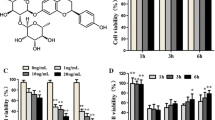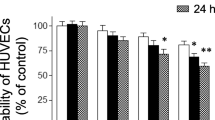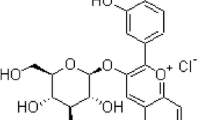Abstract
Sulforaphane (SFN), mainly derived from cruciferous vegetables, has received much attention for its cancer chemopreventive property. Though there have been a few epidemiological studies supporting its beneficial effect on cardiovascular diseases, much experimental evidence are still required to understand its mechanism. In this study, human vascular endothelial cell, a barrier of blood, was used as an in vitro model to investigate the protective effect of sulforaphane on inflammatory damage induced by lipopolysaccharide (LPS). The results showed that sulforaphane inhibited the expression of COX-2 and iNOS stimulated by lipopolysaccharide in a dose- and time-dependent manner. Moreover, sulforaphane suppressed the phosphorylation of ERK1/2, JNK, and p38 activated by lipopolysaccharide. Pretreatment with SB202190, the specific inhibitor of p38, abolished the expression of COX-2 induced by LPS. Likewise, SP600125, inhibitor of JNK, abrogated iNOS expression stimulated by LPS. Moreover, pretreatment with anisomycin (AM), an activator of p38 and JNK, instead of LPS, the expression of COX-2 and iNOS is still inhibited by sulforaphane. Interestingly, SFN significantly induced HO-1 and TR expression down-regulated by LPS. Taken together, these data indicated that sulforaphane exhibited the protective role against the inflammatory injury in vascular endothelia cells, through inactivating p38 MAPK and JNK, as well as inducing phase 2 enzymes.





Similar content being viewed by others
References
Beutler, B., & Rietschel, E. T. (2003). Innate immune sensing and its roots: The story of endotoxin. Nature Reviews Immunology, 3, 169–176.
Chen, J. X., Berry, L. C., Christman, B. W., & Meyrick, B. (2003). Glutathione mediates LPS-stimulated COX-2 expression via early transient p42/44 MAPK activation. Journal of Cellular Physiology, 197, 86–93.
Cipollone, F., Rocca, B., & Patrono, C. (2004). Cyclooxygenase-2 expression and inhibition in atherothrombosis. Arteriosclerosis, Thrombosis, and Vascular Biology, 24, 246–255.
Cromheeke, K. M., Kockx, M. M., De Meyer, G. R., Bosmans, J. M., Bult, H., Beelaerts, W. J., et al. (1999). Inducible nitric oxide synthase colocalizes with signs of lipid oxidation/peroxidation in human atherosclerotic plaques. Cardiovascular Research, 43, 744–754.
Fan, J., & Watanabe, T. (2003). Inflammatory reactions in the pathogenesis of atherosclerosis. J Atheroscler Thromb, 10, 63–71.
Genkinger, J. M., Platz, E. A., Hoffman, S. C., Comstock, G. W., & Helzlsouer, K. J. (2004). Fruit, vegetable, and antioxidant intake and all-cause, cancer, and cardiovascular disease mortality in a community-dwelling population in Washington County, Maryland. American Journal of Epidemiology, 160, 1223–1233.
Ghosh, D., & Scheepens, A. (2009). Vascular action of polyphenols. Molecular Nutrition & Food Research, 53, 322–331.
He, J., Gu, D., Wu, X., Reynolds, K., Duan, X., Yao, C., et al. (2005). Major causes of death among men and women in China. New England Journal of Medicine, 353, 1124–1134.
Juge, N., Mithen, R. F., & Traka, M. (2007). Molecular basis for chemoprevention by sulforaphane: A comprehensive review. Cellular and Molecular Life Sciences, 64, 1105–1127.
Kan, W. H., Yan, W. S., Jiang, Y., Wang, J. Z., Qin, Q. H., & Zhao, K. S. (2002). Role of p38 mitogen-activated protein kinase in lipopolysaccharide-induced expression of inducible nitric oxide synthase in human endothelial cells. Di Yi Jun Yi Da Xue Xue Bao, 22, 388–392.
Kang, O. H., Chae, H. S., Choi, J. G., Oh, Y. C., Lee, Y. S., Kim, J. H., et al. (2008). Ent-pimara-8(14), 15-dien-19-oic acid isolated from the roots of Aralia cordata inhibits induction of inflammatory mediators by blocking NF-kappaB activation and mitogen-activated protein kinase pathways. European Journal of Pharmacology, 601, 179–185.
Kris-Etherton, P. M., Hecker, K. D., Bonanome, A., Coval, S. M., Binkoski, A. E., Hilpert, K. F., et al. (2002). Bioactive compounds in foods: Their role in the prevention of cardiovascular disease and cancer. American Journal of Medicine, 113(Suppl 9B), 71S–88S.
Kuhlencordt, P. J., Chen, J., Han, F., Astern, J., & Huang, P. L. (2001). Genetic deficiency of inducible nitric oxide synthase reduces atherosclerosis and lowers plasma lipid peroxides in apolipoprotein E-knockout mice. Circulation, 103, 3099–3104.
Lin, W., Wu, R. T., Wu, T., Khor, T. O., Wang, H., & Kong, A. N. (2008). Sulforaphane suppressed LPS-induced inflammation in mouse peritoneal macrophages through Nrf2 dependent pathway. Biochemical Pharmacology, 76, 967–973.
Liu, Y. C., Hsieh, C. W., Weng, Y. C., Chuang, S. H., Hsieh, C. Y., & Wung, B. S. (2008). Sulforaphane inhibition of monocyte adhesion via the suppression of ICAM-1 and NF-kappaB is dependent upon glutathione depletion in endothelial cells. Vascular Pharmacology, 48, 54–61.
Lowenstein, C. J., & Padalko, E. (2004). iNOS (NOS2) at a glance. Journal of Cell Science, 117, 2865–2867.
Maier, J. A., Barenghi, L., Bradamante, S., & Pagani, F. (1994). Modulators of oxidized LDL-induced hyperadhesiveness in human endothelial cells. Biochemical and Biophysical Research Communications, 204, 673–677.
Neto, C. C. (2007). Cranberry and blueberry: Evidence for protective effects against cancer and vascular diseases. Molecular Nutrition & Food Research, 51, 652–664.
Pan, M. H., Chang, Y. H., Tsai, M. L., Lai, C. S., Ho, S. Y., Badmaev, V., et al. (2008). Pterostilbene suppressed lipopolysaccharide-induced up-expression of iNOS and COX-2 in murine macrophages. Journal of Agriculture and Food Chemistry, 56, 7502–7509.
Pan, M. H., Hsieh, M. C., Hsu, P. C., Ho, S. Y., Lai, C. S., Wu, H., et al. (2008). 6-Shogaol suppressed lipopolysaccharide-induced up-expression of iNOS and COX-2 in murine macrophages. Molecular Nutrition & Food Research, 52, 1467–1477.
Pirillo, A., Uboldi, P., Bolego, C., Kuhn, H., & Catapano, A. L. (2008). The 15-lipoxygenase-modified high density lipoproteins 3 fail to inhibit the TNF-alpha-induced inflammatory response in human endothelial cells. Journal of Immunology, 181, 2821–2830.
Schafer, A., & Bauersachs, J. (2008). Endothelial dysfunction, impaired endogenous platelet inhibition and platelet activation in diabetes and atherosclerosis. Current Vascular Pharmacology, 6, 52–60.
Shan, Y., Wu, K., Wang, W., Wang, S., Lin, N., Zhao, R., et al. (2009). Sulforaphane down-regulates COX-2 expression by activating p38 and inhibiting NF-kappaB-DNA-binding activity in human bladder T24 cells. International Journal of Oncology, 34, 1129–1134.
Siekmeier, R., Grammer, T., & Marz, W. (2008). Roles of oxidants, nitric oxide, and asymmetric dimethylarginine in endothelial function. Journal of Cardiovascular Pharmacology Therapy, 13, 279–297.
Steffens, S., & Mach, F. (2004). Inflammation and atherosclerosis. Herz, 29, 741–748.
Stoll, G., & Bendszus, M. (2006). Inflammation and atherosclerosis: Novel insights into plaque formation and destabilization. Stroke, 37, 1923–1932.
Tsoyi, K., Kim, H. J., Shin, J. S., Kim, D. H., Cho, H. J., Lee, S. S., et al. (2008). HO-1 and JAK-2/STAT-1 signals are involved in preferential inhibition of iNOS over COX-2 gene expression by newly synthesized tetrahydroisoquinoline alkaloid, CKD712, in cells activated with lipopolysacchride. Cellular Signalling, 20, 1839–1847.
Ungureanu-Longrois, D., Balligand, J. L., Kelly, R. A., & Smith, T. W. (1995). Myocardial contractile dysfunction in the systemic inflammatory response syndrome: Role of a cytokine-inducible nitric oxide synthase in cardiac myocytes. Journal of Molecular and Cellular Cardiology, 27, 155–167.
Wu, L., Noyan Ashraf, M. H., Facci, M., Wang, R., Paterson, P. G., Ferrie, A., et al. (2004). Dietary approach to attenuate oxidative stress, hypertension, and inflammation in the cardiovascular system. Proceedings of the National Academy of Sciences of the United States of America, 101, 7094–7099.
Yun, K. J., Kim, J. Y., Kim, J. B., Lee, K. W., Jeong, S. Y., Park, H. J., et al. (2008). Inhibition of LPS-induced NO and PGE2 production by asiatic acid via NF-kappa B inactivation in RAW 264.7 macrophages: Possible involvement of the IKK and MAPK pathways. International Immunopharmacology, 8, 431–441.
Acknowledgments
We thank the National Natural Science Foundation of China (30872106, 30571558) and Foundation of China Post-doctor (Yujuan Shan), the grant of the key technologies from Heilongjiang Province (GC06TS111) for their financial support.
Author information
Authors and Affiliations
Corresponding author
Rights and permissions
About this article
Cite this article
Shan, Y., Zhao, R., Geng, W. et al. Protective Effect of Sulforaphane on Human Vascular Endothelial Cells Against Lipopolysaccharide-Induced Inflammatory Damage. Cardiovasc Toxicol 10, 139–145 (2010). https://doi.org/10.1007/s12012-010-9072-0
Published:
Issue Date:
DOI: https://doi.org/10.1007/s12012-010-9072-0




